Ripley Entertainment Inc.'s Blog, page 225
January 19, 2020
CARTOON 01-19-2020
January 18, 2020
CARTOON 01-18-2020
January 17, 2020
Podcast For Dogs Launches To Keep Your Pet Calm While You’re Away
Featured in Ripley's Believe It or Not!

This Week
[January 12-18th, 2019] A podcast for dogs, spiders spinning Stonehenge, bone-eating worms, and the rest of the week’s weird news from Ripley’s Believe It or Not!
The Goodboy Podcast
Podcasts have been growing in popularity in recent years, but now humans aren’t the only ones who can stream entertainment on-demand. Spotify is launching a podcast for dogs. The show features doggy praise and stories meant to keep your homebound pooch happy. While an actor can stay home to tell your doggo what a good boy they are, soothing sounds and music are also meant to cut down on barking and help dogs nap away the lonesome hours before your return.

Silkhenge Mystery Solved
In 2013, biologists became captivated by intricate silk structures resembling Stonehenge spun by spiders near the Tambopata Research Center in Peru. No one was sure what kind of spiders were making these structures, or why. Now, at least one of those questions has been answered. The structures act as protective fences for egg sacs. Entomologists still aren’t sure, however, what species of spider is doing this.
Hulk: The Little Green Puppy
It’s not a big red dog, but it is a little green puppy. A German Shepard in Canton, North Carolina gave birth to eight puppies. Seven came out as you’d expect, but one had bright, lime green fur. Lovingly named Hulk, the puppy turned green thanks to a build-up of pre-natal puppy waste built up from the litter. Vets say the coloring is only temporary, and little Hulk’s bright coat will eventually fade.
Bone-Eating Worms Discovered
When scientists sent three alligator carcasses 6,600 feet into the depths of the Gulf of Mexico, that expected to see some strange things, but were surprised to discover a whole new species of worm! The carcasses rested at a depth where light doesn’t reach and plant-life can’t photosynthesize. Scavengers down here thrive on dead things falling from the surface. Bug-like arthropods showed up to feast on the flesh, but a previously-undiscovered bone-eating worm devoured the bones entirely.
Too Cold For Penguins
Though some penguins can tolerate warm weather pretty well, most penguins are known for braving the cold temperatures near or in the Antarctic. Winter at the Calgary Zoo, however, proved too frigid for these flightless birds. Normally, the zoo takes their king penguins for a waddle around the park, but as temperatures dropped below -13° Fahrenheit, they decided to keep them indoors.

Source: Podcast For Dogs Launches To Keep Your Pet Calm While You’re Away
CARTOON 01-17-2020
January 16, 2020
The Controversial Origins Of The Pythagorean Theorem
Featured in Ripley's Believe It or Not!

Learning the Pythagorean theorem in school remains a critical milestone for students of geometry. It paves the way for studying higher math concepts found in trigonometry and calculus. What’s more, this formula represents the ultimate in mathematical elegance:
a2 + b2 = c2
Its creator, Pythagoras of Samos (c. 570-495 BCE), is remembered primarily for his contributions to right-angled triangle math. So, it’s little wonder that he’s known as the first “true” mathematician. But Pythagoras also represented a controversial figure. Not only did he create a secretive religious cult, but whether or not he invented the Pythagorean Theorem remains controversial.

A Controversial Figure
Traditional history tells us that Pythagoras made significant contributions to mathematical developments in the West. That said, sorting out precisely what those contributions were remains problematic.
Why?
Pythagoras left behind no mathematical writings. Everything that we know about him comes from the work of devotees like Philolaus. These authors didn’t delineate what Pythagoras discovered as opposed to his followers.
Of course, when it comes to the ancient world, this circumstance is not without precedent.
The ancient Greek philosopher Socrates didn’t leave behind any written works either. Everything that we know about the philosopher, from the Socratic method to his philosophical teachings, comes from other people.
His knowledge was passed down to us through his students Plato and Xenophon. Aristophanes, the Greek comedic playwright, also got in on the action. However, he presented a less-than-flattering picture of Socrates. But that’s about it when it comes to Socratic source material.
And though we tend to think of mathematics as a factual, objective pursuit, the ancients didn’t see it this way. What we know about Pythagoras comes from murky sources.
Pythagoras founded his school at Croton in southern Italy around 530 BCE. It quickly became the nucleus of a religious-mathematical cult known as the Pythagoreans. Yes, they made advances in mathematics, but history has muddied the waters when it came to Pythagoras’s ultimate contribution to the world of numbers.
The Religious-Mathematical Cult of the Pythagoreans
The Roman historian Cicero reported that whenever a Pythagorean had his beliefs questioned, he replied, “The Master said so.” The “Master,” of course, referred to Pythagoras. His followers gained a reputation for secrecy. As a result, many of their core beliefs took decades, if not centuries, to come to light.

Cropped version of Raphael’s fresco The School of Athens, showing the figure of Pythagoras.
They believed they could reduce everything in the universe down to mathematics. As Aristotle later noted, “The Pythagoreans, who were the first to take up mathematics, not only advanced this subject, but saturated with it, they fancied that the principles of mathematics were the principles of all things.”
Pythagoreans also claimed that Pythagoras possessed supernatural gifts. These included the ability to:
Communicate with animals
Predict earthquakes
Stop the wind from blowing
Stop the hail from falling
Calm the sea’s waves
Remember past lives
Pythagoras’s Dr. Doolittle mythology, coupled with his religious zealotry, has made historians skeptical of source material written by his followers. After all, Pythagoreans worshipped numbers. And they maintained a cult-like devotion that proved not only legendary but deadly.
The Irrational Origins of Mathematics
Nobody understood this better than Pythagoras’s student, Hippasus. Hippasus calculated the value of √2, which was previously thought to be nonexistent. In the process, he discovered a whole new numerical system—irrational numbers.
This discovery undermined the simplicity of the math system beloved by the Pythagoreans. It also contained seeds that could destroy their worldview and religious beliefs. Instead of exploring Hippasus’s discoveries further, they drowned him. And they suppressed his calculations.
Despite this soggy piece of history, Pythagoreans did introduce more rigorous mathematics to ancient Greece. They also made critical contributions to this blossoming field of study.
But they filtered all of their discoveries through the lens of religious zealotry. Their combined zealotry and secrecy eventually led to a violent backlash in 460 BCE. Locals murdered at least 50 members of the Pythagoreans in Croton alone. What’s more, they burned and destroyed many of their meeting places.

The Pythagorean Theorem
And as for the Pythagorean Theorem?
The properties of the right-angled triangle represent some of the oldest mathematical developments in human history, apart from basic arithmetic and geometry. Civilizations from Babylon to Egypt dabbled with the concept behind this theorem about one thousand years before Pythagoras came on the scene.
What’s more, one of the simplest proofs came from China well before the birth of Pythagoras.
Despite these early attempts at the Pythagorean Theorem, many scholars agree that Pythagoras gave the theorem its definitive form. It remains one of the most widely known, with more than 400 different proofs existing today, covering everything from algebra to geometry. But the verdict remains out on whether he defined it or just described it.
By Engrid Barnett, contributor for Ripleys.com
Source: The Controversial Origins Of The Pythagorean Theorem
The Most Exclusive Club That You Won’t Want To Join
Featured in Ripley's Believe It or Not!

On April 5, 1994, in Seattle, Washington, grunge rocker Kurt Cobain, lead singer of the popular alternative group Nirvana, was found dead at his residence, the victim of an apparent self-inflicted gunshot wound.
He was 27 years old and he became the latest in a long line of artists and musicians to die at just that age.
Joining the Club
Between 1969 and 1971, the Rolling Stones’ Brian Jones, as well as Janis Joplin, Jimi Hendrix and Jim Morrison all passed away at the age of 27, and the connection was made in the music press. Soon, it was discovered that others had also passed away at that age, including legendary bluesman Robert Johnson, who died in 1938.
A new debate emerged: Is there a connection between artists and premature deaths—especially at age 27?
Cobain and Hendrix biographer Charles R. Cross wrote, “The number of musicians who died at 27 is truly remarkable by any standard. [Although] humans die regularly at all ages, there is a statistical spike for musicians who die at 27.”
Still, what is the correlation? Could it be the kinds of lives these artists lead? The media, led by Rolling Stone magazine, has taken to calling this group the 27 Club—a list of musicians, artists, and actors who have died at age 27. The club has become an infamous, sort-of cultural phenomenon and, while it has been referenced in music, movies, and pop culture, the idea really didn’t hit the mainstream until Cobain’s death.
Kurt Cobain: Founding Member?
In an interview with The Daily World newspaper, Cobain’s mother could not contain her grief: “Now he’s gone and joined that stupid club. I told him not to join that stupid club.”
Was she making reference to the 27 Club? Some say the answer is yes. And the tragedies didn’t stop with Cobain.

Kurt Cobain || CC Julie Kramer
In 2003, actor Jonathan Brandis committed suicide at 27, and Rolling Stone included him in the club. Actor Anton Yelchin died in 2016 at that same age.
In 2008, musician Amy Winehouse was 24 but expressed fear to several friends and family that she would join the club and die at 27. Three years later, she died of alcohol poisoning at that age, and she now has a permanent place in the club.
Rolling Stone has recognized 71 members of the club ranging from the death of 1892 composer Alexandre Levy to rapper Fredo Santana, who died in 2018.

Street art of members of the 27 Club || CC Jonathan Kis-Lev
And while the thought of this morbid group of celebrities is just a mere passing thought to some artists, others willingly acknowledge the horrors of its existence. In 2008, Pete Wentz, lead singer for the band Fall Out Boy, wrote the song “27” because he thought his own lifestyle was leading him down a road that could end with his own death at 27.
“Are all the good times getting gone?” he wrote.
“They come and go and come and go and come and go.
I’ve got a lot of friends who are stars.
But some are just black holes.”
Coincidence, Conspiracy, and Confusion
The idea of the 27 Club became so prevalent that in 2011, the British Medical Journal took on the topic. The peer-reviewed medical journal conducted an extensive study and found that—in their opinion—there was little to the theory.
While they conceded that young adult artists, and specifically young musicians, have a higher death rate than that of other young adults, they found little connection to the magic number 27.
“Fame may increase the risk of death among musicians, but this risk is not limited to age 27,” the study noted.
The year 2019 saw the deaths of many musicians, all of whom were older than 27, including Ric Ocasek of The Cars (71), Marie Fredriksson of Roxette (61) and Peter Tork of The Monkees (71), among others.
And there may even be some confusion as to which club Kurt Cobain’s mother was referencing. While some conspiracy theorists floated the theory that Cobain may have committed suicide just to become a member of the 27 Club, others say the idea is nonsense, and have deduced that his mother was talking about other relatives who’d committed suicide. Cobain’s two uncles, and another great-uncle, all committed suicide. So, in essence, she may have been grouping those tragedies together into a similarly grim association, calling them a “club.”
Still, as our culture continues to shower fame and fortune on those too young to handle it, it’s almost certain we will see more unfortunate entries to this infamous club.
By Ryan Clark, Contributor for Ripleys.com
CARTOON 01-16-2020
January 15, 2020
A Piece Of The First Trans-Atlantic Telegraph Cable
Featured in Ripley's Believe It or Not!

The Trans-Atlantic Cable
The telegraph may have helped revolutionize communication in the mid-1800s, but it would take a lot more wire before the whole world was connected.
The electric telegraph transmits a series of signals over a wire. By using Morse Code, these signals can be translated into messages. In an era where postal riders were the fastest form of communication across long distances, the telegraph was poised to give humankind near-instantaneous communication anywhere they could bring a cable.

A Morse telegraph/CC Zubro
While poles went up across countries, one communication channel remained dreadfully slow: communications across the Atlantic. Ships and steam liners could take anywhere from six weeks to three months to make a trans-Atlantic voyage. By that time, any news from the opposite side would be long outdated.
The ambitious developers of the telegram thought solving this problem was relatively simple—all people needed to do was run a cable across the Atlantic Ocean.
The project began in 1854. Smaller projects—like a cable from England to France—had already been mounted, and various inventors—including Samuel Morse—were all optimistic that a trans-Atlantic cable could work.
A man named Cyrus West Field eventually took on the project. Though he had no experience with submarine cables himself, he consulted with many experts before convincing the British Government and the U.S. Congress to fund the project.
First, Field needed to begin the manufacturing of the cable. Using a pair of fabrication companies, construction began. The cables consisted of seven copper wires twisted together. The wires were then coated in insulating tree sap. Once the wire was insulated, it was covered in hemp, tar, and then covered in a sheath of iron wires.

The cable was heavy. A single mile of cable weighed over a ton, though it was very flexible and could withstand a massive amount of stress. To lay the cable, two steam warships were outfitted with equipment to release the cable and grappling hooks to get it off the bottom of the ocean if they dropped it.

H.M.S. Agamemnon Laying the Atlantic Telegraph Cable in 1858: a Whale Crosses the Line/By Robert Charles Dudley
The cable broke many times and had to be continually fished out of the sea to be mended, but after multiple tries and falling morale, the cable was finally connected on July 29, 1858. In total, the cable stretched nearly 2,000 miles from Newfoundland to Valentia Island.

Test messages were made to calibrate the signal, but the first official message sent across this marvel of human engineering was from Queen Victoria to President James Buchanan calling the cable “an additional link between the nations whose friendship is founded on their common interest and reciprocal esteem.”
Though telegraph communication across land could be delayed a few minutes as signals were routed and translated, the Queen’s 98-word message took 16 hours to send. The long distance and low signal strength meant messages took a long time to arrive—though they were still faster than any ship.
Unfortunately, the cable broke just a few weeks after the queen’s message. Engineers were appointed on each side of the Atlantic to oversee the cable. Though they enjoyed the convenience of collaborating over the telegraph, the engineer on the eastern side repeatedly used voltage that was too high. This lead to the cable breaking.
The public, proud of the achievement, almost immediately turned sour on the failure. Nevertheless, a new cable was eventually run. The new cable was much thicker and heavier but was also less prone to breaking.
Pop Occulture: Pulling Back The Veil On The Oddities Market
Featured in Ripley's Believe It or Not!

Bottled fetuses. Pinned butterflies. Human skulls. A veritable celebration of the strange and macabre can be seen at the touring Oddities Market. Ripleys.com was on location at their stop in Philadelphia to get the grave dirt on this cabinet of curiosities.
The Dark Arts and Beyond
Adoration for antiques and abstract art was on full display with handmade works from a variety of artisans. Shadow boxes lived up to their ominous namesake with Roadside Linen Arts, who manufactures laser-cut, nostalgic renderings of vintage pop culture, film, and theater paraphernalia. Etched in Embers also fabricates shadow boxes and other woodwork with a twist. These pyrographic productions—the art of wood burning—include surreal renderings as diverse as the gaunt figure of death, characters from Beetlejuice, and the side-profile of a human head with a hyper-realistic depiction of a brain, complete with vein work creatively lifted from the innards of an orange.
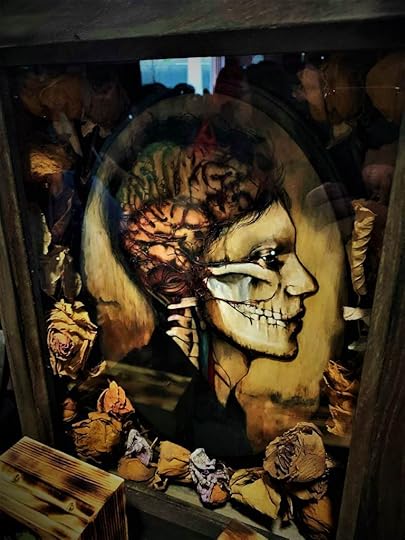
Pyrography by Etched in Embers
A series of guests provided a carnival atmosphere when they brought larger-than-life sideshow banners—literally! Sideshow Banner Exchange’s Michael Papa, co-author of Painters of the Peculiar, brought a massive 10 ft by 8 ft (3 m by 2.4 m) banner of the 614 lb (278.5 kg) man billed as Buster, a work painted by the highly sought-after artist, Snap Wyatt. “Fat Man and Fat Woman sideshow banners typically sell the quickest,” Michael informed us.
“They’re just spectacular. I have a whole warehouse full of them. I can’t get enough of them. I feel like a freak, so I feel like I fit in with them.”
James, the curator of Freeman and Fugate Oddities Company: Purveyors in the Odd, Macabre, and Extraordinary, brought with him Timothy Frank’s Radium Skin Girl banner from the Palace of Illusions carnival sideshow in 1979. It was done in the style of Fred G. Johnson, whose banner paintings were displayed at the Chicago World’s Fair of 1933. The banner mimics the classic style and motif with an orange border and a yellow banner advertising the Torture King, renowned human skewer and pain performer Zamora, who was once himself featured on our very own Ripley’s Believe It or Not! television program.

Also elevated to an art form were talking boards, commonly referred to as Ouija boards. Collected and curated by the Talking Board Historical Society, a registered nonprofit, Treasurer John Kozik affirms that the group’s mission is to “research, preserve, and celebrate the history of talking boards and the people that use them.” In their eight years of existence, the TBHS has raised funds for the headstones of both Elijah Bond, the first to patent the talking board in 1890, and Helen Peters, the woman who named the Ouija board.
“She was kind of written out of history, her story was lost. We discovered through a series of articles in the Baltimore Sun from 1919 that she was really the person responsible for asking the board what it wanted to be called. She was buried in an unmarked grave in Denver, and we put a headstone in telling her story,” explained Kozik.
Kozik, owner of the Salem Witch Board museum in Salem, Massachusetts, was first introduced to talking boards via his grandmother. “Watching her, she definitely believed that she had something channeling through her,” said Kozik, “Her board was dated to the thirties and is very well-worn from where the planchette was. She would move the planchette and spell out all these things faster than anyone could write it down. I was never allowed in the room to know what the questions were.”
“I know at one point the board lied to her and she put it in a trash bag. She never used it again and we were never allowed to look at it.”
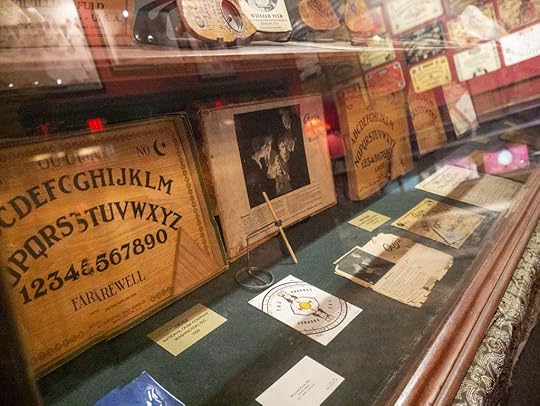
A display case inside the Salem Witch Board Museum in Salem, Massachusetts.
Asc Alchemical provides an old school style of all-natural, unsynthesized perfumes and incense. With the scientific process behind the method of production based on alchemy recipes dating back to the 16th century, Asc Alchemical says it’s “basically witchcraft.”
The couple behind Dark Rain Design assembles a unique craft, even for an oddities festival—a menagerie of mechanized monstrosities that respond to human touch, like a smartphone. Sterling, co-creator of Dark Rain Design, explained that these fascinating, steampunk-themed robotics, coined Clockwork Critters, “are actually designed by repurposing parts from old kids’ toys. Steampunk is all about taking old things and making them into something new. So what we do is we take old toys from thrift stores that kids have gotten tired of that did cool mechanical things already, then reutilize those parts and do something new.”
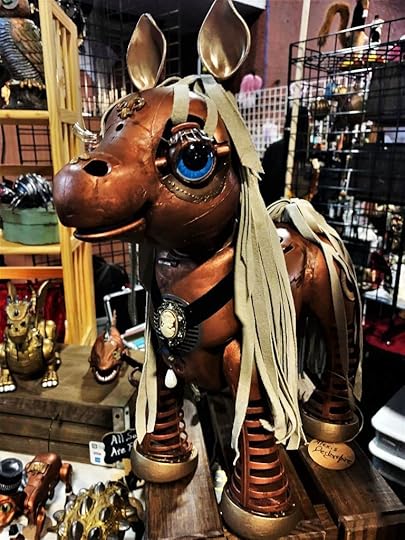
An incredible feat of “minor escapism,” one of the animatronic Clockwork Critters by Dark Rain Design.
Unlikely Animal Advocacy
The Oddities Market was all about repurposing, whether that be mechanics, bones, or entire animal corpses—not to mention the entomological variety of pinned and preserved insects. One of the most striking pieces on display was Brain Fever Artwork’s take on the theatrical poster of The Silence of the Lambs, with the image of the iconic death’s-head hawkmoth replaced with the genuine article. Sammi, the artist behind Brain Fever Artwork, revealed: “I actually went to school for medical illustration, so I kind of got used to dealing with really gross stuff. I’ve always had pet bugs growing up.”
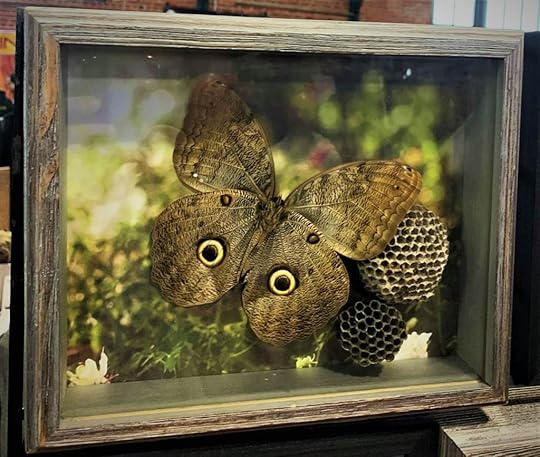
Sammi from Brain Fever Artwork’s personal favorite of her collection: an owl butterfly specimen with long-since depleted honeycombs from a beehive.
Inanimate inhabitants of insectariums—terrariums with preserved insect figures—were not the only creatures displayed at the market, as taxidermy projects could be found in abundance. Though popular media can portray taxidermy with undertones of sportsmanlike combativeness or indifference toward the lives of animals, the truth is really the opposite. In all actuality, taxidermy could best be described as an expression of admiration and love for these creatures. Ostensibly an outward contradiction, but for these taxidermists, the idea of hurting living animals is anathema to their ideals.
Walking past Afterlife Anatomy’s table of assorted buffalo and bull jawbones, we came across a two-headed calf that, as the story goes, was bred in Nevada as a result of atomic bomb tests. It made its way to a bar in the seventies, where it was photographed partying with notorious Hearst Magazine’s heiress, Patty Hearst, before finally making its way to Katie Innamorato, proprietor of Afterlife Anatomy. She informed us that taxidermy competitions exist at the state, national, and international levels, which she has competed at over the past ten years. Prior to becoming a taxidermist, Katie initially aspired to be a veterinarian. However, she was too scared of hurting living animals: “It was just too much pressure for me to consider. Messing up a living animal is worse than messing up a dead animal. It’s a weird medium for it, but I love animals and that’s why I like trying to create them as best I can.”

Every practicing taxidermist at the market was emphatic about their hides, accompanying bones, and viscera being humanely obtained. Artist Tia Callahan from Second Chances Oddities declared that “everything’s cruelty-free. I take a lot of pride to make sure that everything’s ethically sourced.”
“I really just want to find the beauty in animals, even after death.”
Callahan’s goal is unquestionably achieved with her hauntingly romantic juxtaposition of spindly skeletons and assorted memento mori symbols set in beds of flora—dried, yet lush greenery, vibrant rosebuds, and even live succulent plants to decorate Victorian-motif frames and lanterns.
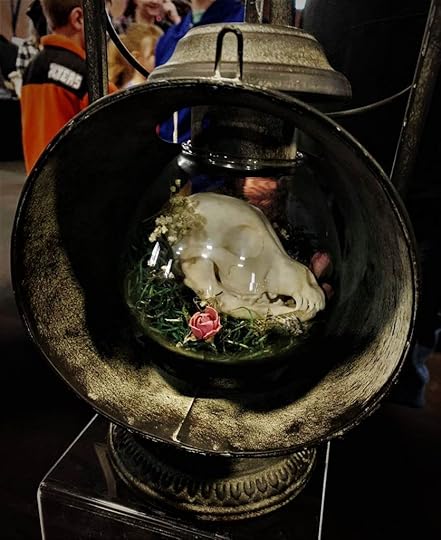
Victorian lantern containing a memento mori amid flora by Second Chance Oddities
Wildlife and nature scenes were not enough for Brandon and Julie Howey. The self-taught taxidermists at Eerily Beloved specialize in anthropomorphic scenes that are horror, sideshow, and circus-themed. “We really wanted unusual taxidermy. We wanted to make stuff we wanted,” said the Howeys.
“There’s something about wildlife being preserved forever that’s extra special.”
The majority of their supply is sourced from roadkill, after which: “We give them to a bird sanctuary so they’re able to eat the carcasses. We just keep the skin.” They aspire to someday open a bar decorated with their brand of “offbeat counterculture.” Talk about a petting zoo brew!
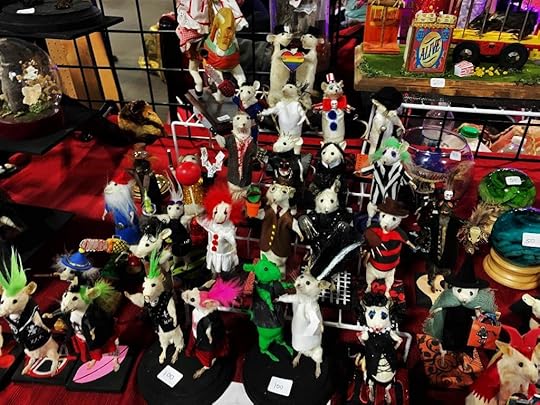
Specimens displayed by Eerily Beloved
Misty Hyneman of Cabinet of Creations holds a Ph.D. in neuroscience and specializes in the practice of diaphonization: the chemical process of clearing and staining a specimen. This mesmerizing process is applied to wet specimens stored in jars of a chemical called trypsin, which removes all color. With just the transparent version of the specimen left, dyes can be applied to create a brilliant spectrum of neon colors.

For Hyneman, this endeavor helped her conquer her fear of snakes after purchasing a specimen online: “I thought, ‘I’m going to conquer this fear… slowly.’ Then it kind of just turned into this amazingness! It took a couple of months before I stopped dissolving things because that’s really easy to do.”
Hyneman’s mother, Suzanne, assisted her daughter at the booth. For her, death was a regular part of southern life. “We’re originally from Alabama,” Suzanne explained, “When I was young, they always had the viewings in the home. I don’t know if they still do that or not. It’s really kind of a way to be at peace with things.” In regards to her daughter’s art, Suzanne said,
“It’s better than burying it. Now you’re extending its life beyond death.”

Tim Prince of Forgotten Boneyard self-produces and exhibits mind-bending creations that must be seen to be believed. Standing next to a totem pole of skulls swarming with crawling scarabs, which he modestly described as “literally just me having fun,” Prince divulged: “The entire reason I got into this was because I didn’t see anything else like I wanted to create.”
Prince disclosed that he finds inspiration in the works of Swiss surrealist artist H. R. Giger, who is best known for his Oscar award-winning design of the titular Xenomorph from the 1979 horror classic, Alien. This influence is readily apparent when taking in his otherworldly mount of Medusa’s Skull, a human skull fixed with snarling skeletal snakes. Prince’s work is all ethically obtained.

“I process a lot of roadkill, natural deaths from pet stores, and things from butchers,” says Prince.
Not unlike the funeral rites indigenous to Tana Toraja, which sees care for the corpses of loved ones for years prior to their internment, for taxidermists, the expression of love does not cease with death. This was the prevailing sentiment at the Oddities Market, which falls under the umbrella of the “death positive” movement.
Exhuming the Death Positive Movement
Taxidermy and insect preservation were not the only cadaverous holdovers from the Victorian era. Also present that day were an eclectic collection of post-mortem photography, medical slides, and a plethora of support for the death positive movement. Britney Jones from Mz. Jones’ Curiosities casually explained what is commonly thought of as a stomach-churning, imponderable concept—death.
“My husband was a funeral director, so he’s taught me how to embalm things the proper way.” Britney Jones and her husband, Neil, now focus on wet and dried-out specimens for mummification, while also utilizing chemicals to break them down to the bone. Neil’s mother was a pathologist, which normalized the concept of death growing up within his family. Britney initially wanted to be a funeral director but was dissuaded after discovering how difficult it was for women to join the industry at the time she aspired toward it.
“I wanted to do it ever since I was a little girl. I wanted to work with dead people. I watched it and it just felt right.”
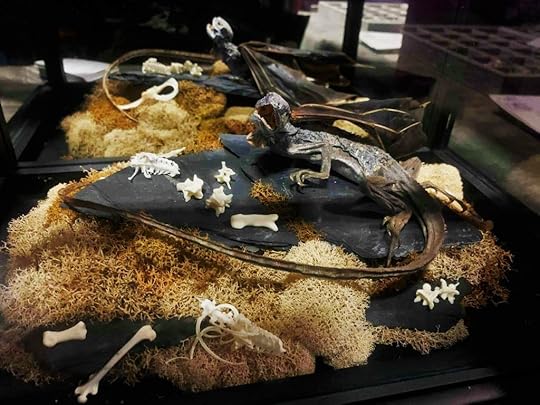
Enter the Dragon’s Lair, diorama by Mz. Jones’ Curiosities.
When asked if she gets along better with the dead than the living, Britney admitted, “a little bit. We have a little bit better of an understanding that these things are going to die. It’s going to happen. Why bury it? Why hide it? Don’t sugarcoat it. It’s messy, let’s get involved. Let’s put it on our walls and show appreciation.”
Bad News Vintage stood just a few stalls down from Mz. Jones’ Mini Oddity Machine, a gruesome take on gumball and other candy vending machines that, with four quarters and the twist of a knob, gifted customers with bones, teeth, crystals, or wet specimens, including wasps, mouse paws, iguana toes, and the partial remains of bobcats, zebras, and wolverines.

Embracing death may be a bridge too far for some, but it wasn’t always like that. Just take a look at the disquieting practice of post-mortem photography. While he examined a lock of hair encased with a photograph of a deceased infant, Greg Trout from Bad News Vintage gave some insight on this bizarre practice: “It used to be common when child mortality rates were a little higher, people would preserve something about their child. Commonly a lock of hair because that was easy to preserve. The practice all but died out in the early 1900s.”
When asked what the draw of the weird and the morbid is, Trout responded: “I don’t really know entirely what draws anybody to anything. The best example I can give is I listen to a lot of music that people find unsettling. I don’t know what it is. I enjoy listening to it. I don’t want to question it much beyond that. I think it’s the same thing here. Why are these old, weird medical slides so interesting? I couldn’t tell you, I have no idea. I think just the fact that it happened, it’s a record of it happening, and it happened in a world we might not recognize today.”
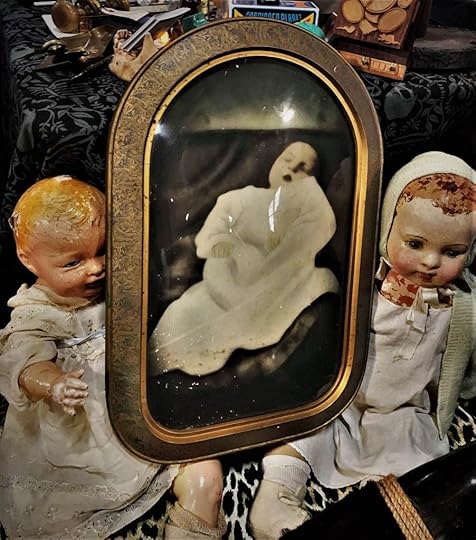
“This is a photo of a post-mortem baby. I’ve had that for about twenty years. I bought that from the estate that the baby came from, but nobody remembers the baby’s name. So we’ve been calling her Mabel all these years.” -Kristi Howard, Precious Lost Things.
Despite the macabre atmosphere, all ages are encouraged to explore the oddities on display. For a place so full of death, there’s a vast repository to display different ways of life. With the wild success of the Oddities Market, it is safe to say that the world of the wistfully weird has found itself a home on the road.
By Kris Levin, contributor for Ripleys.com
Kris Levin is a traveling storyteller, professional wrestling referee, and everybody’s favorite nephew. He can be seen internationally on IMPACT Wrestling as their most junior official, #KidRef, and on social media at @RefKrisLevin .
Source: Pop Occulture: Pulling Back The Veil On The Oddities Market
CARTOON 01-15-2020
Ripley Entertainment Inc.'s Blog
- Ripley Entertainment Inc.'s profile
- 52 followers








